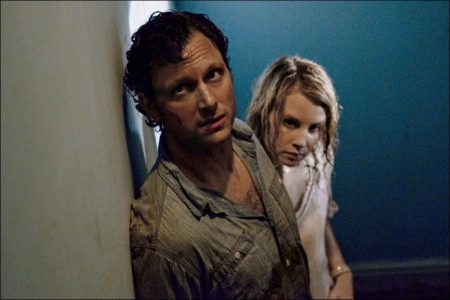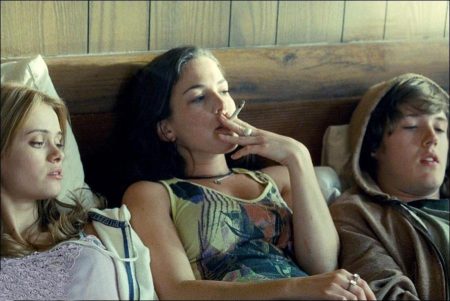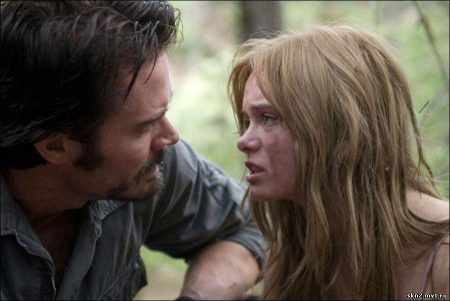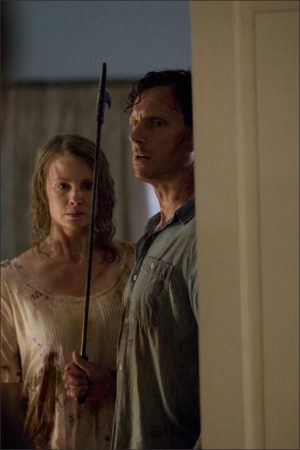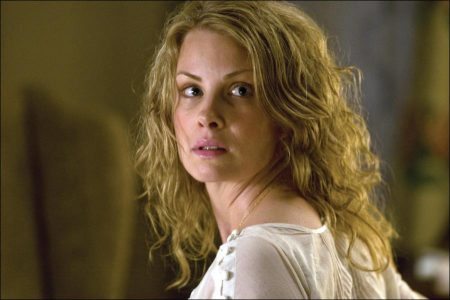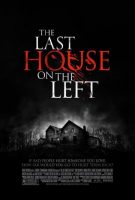The Last House on the Left Movie Trailer. Flash forward 30-plus years. Intrigued by the astonishing success of such horror remakes as The Texas Chainsaw Massacre and Craven’s own The Hills Have Eyes, the producing partners pondered revisiting The Last House on the Left. Craven offers: “Because the original had been produced on such a minuscule budget, there were many aspects of the story I simply couldn’t afford to explore. Fortunately, the new version has a much bigger budget, so we were able to greatly expand the production’s scope and take more time and care in shooting.”
In order to reintroduce this classic to contemporary audiences, Craven and team began to look for a rising young director to bring a new perspective for the story told 37 years later. It would require a visual innovator-someone with not only a dark imagination but also a talent capable of revisiting the action, gallows humor and terror of the landmark film. Better yet, he needed to integrate the elements into a distinct, new experience.
Over the course of a year, the team and Rogue Pictures considered nearly 100 different directors for the position. The project’s co-producer Cody Zwieg was impressed after he saw Greek director Dennis Iliadis’ film Hardcore, the controversial story of four teenage prostitutes in modern-day Athens. After viewing the film, he encouraged Cunningham, Craven and Craven’s longtime producing partner Marianne Maddalena to see it. His producers were equally impressed by Hardcore and its provocative, fresh approach to the world’s oldest profession. “We all agreed it was brilliant,” says Maddalena.
Hardcore top-lined Variety’s Critics’ Choice awards as one of the best films by new European directors for 2005, and the film also won the prestigious German Independence Award. Moreover, the independently produced, low-budget film had exemplary production values, showing that Iliadis was a savvy filmmaker who could be highly creative within budgetary constraints.
“We knew the remake would only work if we could find someone who could create strong characters while handling the more extreme moments,” explains Zwieg. “Hardcore wasn’t a genre or a horror film but showed completely believable characters in horrific, realistic situations. Many directors could handle the surface elements, the blood and shock moments of Last House, but Dennis proved that he could do it all without exploiting his characters and their situations.”
Iliadis jumped at the chance to work with Craven on Last House and make the movie his American debut. “I’ve seen all of Wes’ films and loved them,” he states. “This film is based on a very archetypal story and primal story, which is a great foundation. I wanted to keep all the shock value and the power of Wes’ film and develop the story in my own way.”
With Hardcore, Iliadis had elicited performances of depth and beauty, while working with mostly nonprofessional actors for a long rehearsal. He would bring those learned lessons to Last House. “You must discover the characters with the actors,” says the director. “We rehearsed for a month-and-a-half on my first film. We got to a place where we could shoot very difficult scenes very quickly, because we had developed the characters in rehearsal. All the extreme scenes came out naturally after that.”
Using Craven’s original screenplay as the template, the production team assigned writer Adam Alleca and then Carl Ellsworth with the task of updating and fine-tuning Last House. Ellsworth, who worked with Craven on Red Eye, relished the opportunity to revisit his director’s inaugural property. “This is a classic good-triumphingover-evil movie. I wanted to thriller-ize it. At the end of the day, it’s about normal everyday people in extraordinary circumstances, and it doesn’t get anymore extreme than this.”
Iliadis welcomed the challenge of interweaving visceral thrills with complex characters. “I want this to be a film that grabs you and never lets you go,” he says. “At the same time, it should make us think a bit about human nature. Who is civilized, who is uncivilized? Who is violent, who is normal? Our film grabs you by the throat and tells us some things about human nature. We are an interesting species.”
Victims and Victimizers: Casting the Film
From his first thoughts of approaching Last House, Iliadis knew the key element to bringing the audience into the Collingwood family’s terrifying ordeal would be perfect casting. He was certain the audience had to be viscerally drawn into the experience, as if they were watching their own friends in the throes of the deepest darkness.
Filling the pivotal role of champion young swimmer Mari Collingwood was first on the agenda. Finding a young actor with the depth needed to provide the roller-coaster range of emotions was not easy. The director and production team considered dozens of young talent before settling on Sara Paxton.
Known for her work in such popular comedies as Aquamarine, Sleepover and Sydney White, Paxton wasn’t an obvious choice for the emotionally intense role. Discussing Paxton, Iliadis remembers, “She had played these very specific roles in high school movies, but she’s a person of amazing intelligence and instincts. I immediately saw this intelligence in her eyes, and her intensity made this film deeper. I was really looking for a pair of eyes that could tell the story and make you empathize with this character. She’s given an amazing performance and a very brave one.”
Paxton welcomed the opportunity to throw herself into such a physically and emotionally draining role. Says the performer, “For a long time, I’ve been doing comedies and playing really lighthearted characters. I wanted to be challenged with something different…something I could sink my teeth into.”
Still, she understood the challenges that would lie ahead if she got the part, especially the scene in which Paige is brutally killed and Mari is assaulted. “I had my concerns about the movie being too graphic, gruesome or sexual when I was in the mix for the part,” Paxton explains.
“Dennis invited me to his office to have a conversation because I was pretty worried. I had this whole argument planned out about why I felt that way and what I felt shouldn’t happen. But Dennis already understood; he in no way wanted it to be that way. The whole assault scene was not to be sexual in any way. I didn’t want there to be a single moment where a person could get turned on. It’s completely an act of violence and horrifying.”
Paxton’s attitude and much needed humor in the midst of unpleasant working conditions astounded the production team, especially when she insisted on method performance. “Sara has had to do the most ridiculously difficult scenes in this movie,” says coproducer Jonathan Craven. “We had her crawling through the woods with huge rain rigs at four o’clock in the morning. She’s wearing her underwear and a Tshirt and crawling through the mud with huge amounts of rain…while everybody else is freezing and wearing big coats. She came out and did the scene and went back to dancing in her trailer afterwards. That says it all to me.”
Revisiting Last House is especially poignant for the co-producer, who appeared in the original. “I was six years old holding a balloon, which was popped by the original Krug,” Jonathan Craven laughs. “It’s always been one of my favorites of my father’s films. And so I was very excited to become involved. I felt like I wanted to protect the film; I had so much love for the first one.”
For the role of Mari’s mother Emma, the team secured actor Monica Potter. Known for her work in comedies such as Patch Adams and Head Over Heels, she’s also no stranger to the thriller/horror genre-having starred in the mega-successful films Saw and Along Came a Spider, based on the blockbuster novel by James Patterson. “When Monica read the script in rehearsals, she was hysterically funny,” recounts writer Carl Ellsworth. “When she first started reading, her character suddenly had this dry sarcasm. So, I found myself writing dialogue to mirror this dry sense of humor.”
A mother of a teenager in real life, Potter responded to the themes the film explores. “What attracted me most to this movie was the family’s relationship, especially with how they were dealing with losing a son,” she provides. “They want to protect their child, and that’s the heart of it. You would go to any lengths to protect your daughter, especially having lost your son.”
Playing opposite Potter in the role of Dr. John Collingwood is veteran actor/director Tony Goldwyn. Goldwyn was attracted to the part of the man who must go to unimaginable lengths to protect his family because it “pushes the envelope.” Initially, however, he, like Sara Paxton, had serious reservations about participating. “I was shocked when I read how violent it was,” he says. “So Marianne sent me Dennis’ movie Hardcore, and I thought it was so brilliantly done and showed such attention to detail; there’s humanity to it. That movie was very in your face as well, and shocking in a different way. I could see I was in the hands of a talented director.”
Iliadis appreciated Goldwyn’s vast knowledge and work as both actor and director. From episodic television shows to films such as A Walk on the Moon and The Last Kiss, Goldwyn’s experience was a definite plus. “It’s terrific having an actor who understands lenses and eye lines,” his director commends. “Very often, he gave minor adjustments that helped things move faster.”
Playing Mari’s townie girlfriend Paige is actress Martha MacIsaac. This up-and-coming performer, having recently co-starred in Superbad, expands her range in the thriller genre with her latest film. MacIsaac describes Paige as “a loose cannon. She is the free, wild, funny one who goes from laughing her head off and smoking pot to terrified out of her mind at being tortured…it’s been so much fun to play.”
MacIsaac was as surprised as Paxton at the grueling demands of her role. “I’ve never done such a physical part,” she states. “We did a lot of our own stunts…like falling down hills and being tackled. I had a lot of days of running through the woods in a miniskirt and boots, which you would think would be a really awesome outfit for that. It’s not.”
The Last House on the Left is ultimately a story of two families whose lives become tragically intertwined during the course of a 24-hour period. Iliadis was fascinated with the parallels between the two fathers who represent polar opposites. “There’s a family who can only survive through conflict and drama, and there’s a family who tries to do the right thing,” he notes. “But there are similarities. To make it work, there should be similarities between the perfect father and the sadistic criminal father.”
Inhabiting the villainous character of gang leader Krug is No Country for Old Men’s Garret Dillahunt. After auditioning dozens of actors for the role, Iliadis was impressed by Dillahunt’s sly approach to embodying evil incarnate. It helped that he had done a television pilot with Paxton several years earlier, so there was a friendship between the two. “We were auditioning for Krug, and everyone was trying to play him like a typical bad guy,” the director recalls. “That’s always a big mistake; even the most sadistic criminal will smile. You need to see him smile and his eyes change. Garret brought this whole ambiguity and subtleties.”
Dillahunt felt he had to humanize Krug if he would ever hope to understand the psychopath and his despicable actions. As he prepared for the role, he read several books about serial killers and their conjectured motivations. The actor describes his character as “an escaped convict who is not a very good father, although he loves his son very much. He’s bitter that things haven’t worked out better for him. He’s trying to preserve the bond of his little twisted family. He’s the leader of this pack, and he’s trying desperately to hold on to that position.”
Jonathan Craven elaborates on Krug’s paradoxical nature. “Krug has been dealing with his own failures…and it adds up to a very unique villain and someone who is almost a good father but also the worst human being in the world. It’s very strange; he’s got empathy for his son, but it’s twisted on itself. It’s so abusive, dark and horrible.”
Surrounding Krug are equally vicious gang members who spur him on to escalating acts of mayhem. Dillahunt explains: “They’re spree killers who almost don’t seem concerned with covering their tracks or their trail. His band seems to be on that same death spiral with him. It’s like they’re on fire and they’re doing as much damage as they can before they get snuffed out.”
Portraying Krug’s sadistic brother Francis is actor Aaron Paul, best known for his work on the critically acclaimed series Breaking Bad. Paul had originally turned the role down, but the production team wouldn’t take no for an answer. “I just chased him. I basically stalked Aaron until he finally accepted the part,” shares producer Maddalena.
Paul relished the opportunity to play such a nasty character. “I’ve never played anything like this. I just love to zip on a completely different skin. It’s nice to dive into a completely crazy character. Francis is an evil, very sexual human being. He loves to toy and mess with other innocent harmless creatures.”
Actress Riki Lindhome came aboard to portray Krug’s deadly girlfriend Sadie. “She’s a sociopath,” sums Lindhome. “She likes killing people. Sadie isn’t someone who thinks ahead. She does whatever she feels like doing and then just deals with it.” To get in the mindset of the killer, Lindhome had to imagine a woman who was “100 percent devoted to Krug. Sadie will wait for him if he goes to jail. She will break him out of jail. She will risk her life, do anything to be with him.”
Rounding out the cast is Gladiator’s Spencer Treat Clark, who portrays Krug’s hapless son Justin. Clark had a hard decision to make when it came to the shoot. “I was torn at the time,” he confesses. “I was in my second year of college-three weeks into the semester-when this role came up.” What sealed the deal for him was realizing Justin was the moral center of the film and “the conduit for the audience.” He shares, “There’s very little backstory, so we don’t really know where Justin is coming from. We don’t know how long he’s been on the road with his father, Sadie and Francis.”
Once the Los Angeles-based production team cast the roles, the actors grabbed their bags and flew to Cape Town, South Africa for an intensive week of rehearsals. For Iliadis, scheduling days of lengthy rehearsal sessions before shooting is the key to eliciting performances of depth and truth. “Trying to find the truth in the script and in the characters…you must discover the characters with the actors. I really push them to give me ideas and not to stick to the page. Once they get this space, it’s amazing. I push a lot in the beginning, and then I sit back.”
Production Design: Building The Last House on the Left
Because the film began production in spring 2008, the possibility of inclement weather prevented the filmmakers from returning to the Westport, Connecticut, location of the original shoot. Therefore, they broadened their search across the globe.
The quest took them from the western states of America to Romania and finally to Cape Town. In this city, they found the combination of experienced crews, cost incentives and isolated lakeside locations that could easily double for the Pacific Northwest forest where the film was set.
Explains Iliadis: “I’ve shot commercials here before; this is where commercial crews go in the winter. You’ve got an amazing range of locations. You can shoot anything in the States here, from the Northwest to the Southeast.”
The team chose South African Johnny Breedt as the production designer for the film. Breedt looked forward to returning to the genre, having worked on the Craven production The Breed in Cape Town a few years back. “I’ve worked on about 10 horror films, and they have all been great fun,” states Breedt. “With horror movies, you get to play…do things you would never get to do in a period drama.”
As much of the film’s action takes place at the Collingwoods’ isolated lakeside compound, finding the idyllic haven to create fear was a priority. Breedt and the production staff scoured the countryside in search of an appropriate venue. “This was the most difficult location to find on this movie,” he explains. “We would go from location to location, and nothing seemed right. It got to the point where I thought maybe we were making the movie in the wrong place.”
After weeks of fruitless searching, the team discovered a pine-forested parkland reserve that was conveniently located 45 minutes outside of Cape Town. The last house on the left-as well as guesthouse and detached garage-would need to be built from scratch on the reserve property.
In order to lend authenticity, it was decided that the lake house exteriors and interiors would be constructed on the reserve. “There was originally the idea to build the exterior on location and shoot all the interiors onstage,” recounts Jonathan Craven. “Dennis, Sharone and the producers came to the agreement that we wanted to build the whole thing as a fully functioning house set on location, so that we could shoot in and out without having to relocate. It’s not as convenient as being on the stage when you’re shooting nights, but it was integral. We were all night owls for three weeks.”
The plans for the Collingwood house and guesthouse were loosely based on a century-old updated farmhouse nestled on Martha’s Vineyard, Massachusetts. Careful consideration had to be taken with every detail of their design and execution. With hundreds of researched photographs scrutinized, Breedt and his design team imagined the ideal American getaway.
At a rapid pace, the crew constructed the Collingwood compound-main house, guesthouse, detached garage and extensive grounds-in just a few months’ time. To top it off, every surface needed to look as if it had been gently weathered from years of exposure to Mother Nature.
Through years of trial and error, Breedt and his staff came up with ingenious techniques for creating the illusion of antiquity, which they utilized for the compound. “If you give a house history, it gives a film layers,” reports Breedt. “It’s quite an old house, and it’s been renovated throughout the years. If you look at the exterior of the house, it’s aged very cleverly.
It looks like it’s been painted repeated times, but in fact it’s only been painted with a base coat and a final coat. We have a technique to use plaster that you trowel on. Then you paint it, scrape it all off and lightly touch it up with a magic brush. When people came to the reserve and knew nothing about the house, they thought it had been here forever.”
With snapshots in hand, the production designer sent his team scouring the secondhand shops and flea markets of Cape Town in search of quintessential American building materials, household furnishings and accessories. Although the crew combed the city in search of familiar Americana, much had to be shipped over from the States. Tiny details, from lightswitch plates and plugs to blankets and dish towels, would make the difference to the audience’s belief they were in America.
As much of the action of the film takes place during torrential thunderstorms, extensive rain rigs attached to immense 120-foot cranes had to be constructed over the Collingwood property. Of the challenges, Iliadis laughs: “I want to tell writers that when they write rain into a script, it’s not that easy! We decided to shoot the house on location, with everything in the woods in the middle of the night with rain. The pipes are clogging, and it’s been a big challenge. In the end, it gives a visual layer to the film that’s very interesting.”
Makeup of the Film
One of the primary reasons for the success of Wes Craven’s 2006 production of The Hills Have Eyes was the stunning contributions of Academy Award-winning KNB EFX Group Inc. Consequently, there was never any question as to whether The Chronicles of Narnia: The Lion, the Witch and the Wardrobe designers would create the special effects makeup for The Last House on the Left.
KNB and Craven have enjoyed a long partnership, creating iconic movie monsters for years. “We’ve worked with Wes and Marianne for a dozen years,” explains KNB’s Gregory Nicotero. “Our first project for them was The People Under the Stairs. We’ve done all of Wes’ films since then. Wes has a good eye for the characters since he has lived with them for so long. He knows exactly what he wants, so he can look at designs and go, `Love that; don’t like that.’And that’s it.”
From bullet holes to gashes, South African prosthetics supervisor Clinton Smith brought an eye to detail that greatly impressed the production team. “Clinton’s as good as any special effects makeup artist working in the States,” says Maddalena. “He worked 24/7, giving us the most realistic gore effects imaginable.”
Ever the good sport, Sara Paxton relates of the experience: “I was so excited to get all bloody and dirty. I had this gash on my forehead from the car crash in the woods, and I was really excited about it. Then, after about day five, I didn’t like it anymore. Nobody can make eye contact with you because you’re so dirty and messed up. I looked like I had been hit by a truck.”
Thanks to KNB and its South African counterparts, there was never a dull moment on the Last House set. “We had a lot of bloodthirsty people working on this movie,” tells co-producer Jonathan Craven. “We had lots of hammers going into heads…broken noses, blood-spurting rigs and great gruesome things-not to mention people who salivate noticeably when they get to apply blood.”
Cinematography and Visual Effects
A large part of the thrill of Last House is its extraordinary visual energy. For Iliadis, forging a sharp look and visceral feeling of mounting tension for the film was a priority, which is why he recruited cinematographer Sharone Meir for the project. Meir’s masterful work on Mean Creek created the almost unbearable nervousness that the director wanted for this project.
Iliadis notes that the two often enjoyed spirited debates during the shooting of the film. He laughs, “Well, we are two Mediterraneans, so that makes it very colorful. We’re like a strange married couple. We argue a lot, and we have interesting conversations. It’s always loud, but in the end, it’s a very loving relationship.”
Wes Craven had nothing but praise for the cinematography of the 2009 version that Iliadis created with Meir. “Meir captured the spirit of the original and captured the performances beautifully,” compliments the filmmaker. “He shot one of the most powerful moments I can recall in a recent film: Mari heading for the water, following the assault scene. There is so much humanity and grace in that shot; it’s astonishing.”
Working alongside KNB was Twilight, The Hills Have Eyes and its sequel’s innovative visual effects supervisor, Jamison Goei. From bullet holes puncturing a tranquil lake to heads frying in a microwave, Goei and his team of high-tech artists seamlessly crafted visual effects shots for the film.
There was one aspect of filmmaking about which Goei and Iliadis were always in agreement: inserts would be kept to a bare minimum. “I hate inserts,” states the director. “I wanted almost everything to be right there before the camera. I hate cutting to something that is out of context just to get the gore right. I like to incorporate it into the action, which is more difficult but more effective. The gore and the balance happen during the take. It feels more organic and more shocking rather than doing the fancy inserts.”
The Last House on the Left (2009)
Directed by: Dennis Iliadis
Starring: Tony Goldwyn, Monica Potter, Sara Paxton, Garret Dillahunt, Rhys Coiro, Martha MacIsaac, Riki Lindhome, Aaron Paul, Michael Bowen, Spencer Treat Clark, Tony Goldwyn
Screenplay by: Carl Ellsworth
Production Design by: Johnny Breedt
Cinematography by: Sharone Meir
Film Editing by: Peter McNulty
Costume Design by: Katherine Jane Bryant
Art Direction by: Shira Hockman, Cecelia van Straaten
Special Effects: Süpervizörü Jamison Goei
Music by: John Murphy
MPAA Rating: R for sadistic brutal violence including a rape and disturbing images, language, nudity and some drug use.
Oizüdisuüeo sl: Rogue Pictures
Release Date: March 13, 2009
Views: 143
